Imagine a vibrant Monday morning at your company. The Marketing team is gearing up for their latest campaign launch, a social media offensive, and the cloud resources are humming into action with new collaterals posted to the internet horizons.
However, the Finance department is in a whole other vibe. Their inboxes start getting filled with cloud cost alerts from the cloud provider, threshold barriers broken and costs mounting up and traversing well above the benchmarks.
There begins the blame game in full swing, teams pointing fingers at each other and engineers caught in the crossfire. What was planned as a well-budgeted, highly anticipated marketing celebration has turned into a financial, technical, and strategic quagmire.
While it has a comic tone to it, this is a pressing dilemma faced by almost every business out there in the cloud, which is, the challenge of delivering the expected performance all while optimizing cloud costs. Scenarios like these call for policies and frameworks like Cloud FinOps, to avert financial upheavals even before they unfold.
What is FinOps?
It involves an act of synergy that unites Finance, Engineering, and Business functions, fostering shared accountability within cloud financial management. We can draw similarities of a cloud FinOps process with our favorite superhero movies, like ‘The Avengers’. The cloud FinOps practice is an ensemble of various powers that contribute a larger effect to the business finances.
The Finance Team: With their arsenal of budgets and fiscal reports, they champion transparency and accountability in cloud expenditure.
The Engineering Team: Experts in infrastructure and resource stewardship, they fine-tune cloud deployments for peak efficiency and cloud cost optimization.
The Business Team: Ever poised to meet and exceed business objectives, they steer cloud investments towards the pinnacle of value and return on investment.
Cloud FinOps is much more than saving money. It's about making strategic choices concerning cloud resource allocation that align with business objectives. It offers a sweet spot between agility, performance, and cost efficiency in the cloud.

Cloud FinOps vs. FinOps
The terms “FinOps” and “Cloud FinOps”, although used interchangeably, represent slightly distinct concepts.
FinOps: This is a broader term that means the financial management practices related to any technology environment or ecosystem, and that too, encompassing on-premises, cloud-based and hybrid systems.
Cloud FinOps: Specifically applies to FinOps principles within cloud computing realms. The discipline helps tackle cloud cost-saving challenges associated with managing fluctuating costs and optimizing performance. Cloud FinOps practices focus on improving resource utilization using techniques and tools specially tailored for the cloud.
The benefits of Cloud FinOps
Now you know the fundamentals of FinOps, but you might be thinking - why should this be important to you? What benefits could it possibly bring to you and your business?
Let’s see how Cloud FinOps helps you unlock the full potential of your cloud investments.
1. Enhanced Cloud Cost Savings
- Reduction in Cloud Expenditure: One of the most obvious and widely known advantages is the reduction in cloud costs. The savings directly get translated to the financial efficiency of the business.
- Minimizing Cloud Wastes: By pinpointing and eliminating underutilized resources, excess storage, and suboptimal configurations, cloud FinOps ensures that every penny spent is completely optimized, contributing to long-term cloud cost savings.
- Rightsizing Resources: Organizations can select the most financially viable resource options, tailored to their specific needs, exactly as per the requirements. This will again, lead to significant savings.
2. Visibility and Control Aiding Strategic Decisions
- Expense Tracking: Cloud FinOps helps gain enhanced visibility on cloud utilization and resource-level costs, granting the clarity needed to make strategic resource management and optimization decisions.
- Budget Forecasting: Better visibility in turn helps with precise budgeting, enabling organizations to anticipate cloud expenditure and mitigate the risk of cost overruns.
- Cloud Resource Governance: By implementing governance protocols, cloud FinOps ensures the responsible and efficient use of cloud resources, minimizing the possibility of wastage.

3. Boosted Innovations
- Better Time-to-Market: Cloud FinOps streamlines resource management, helping quicker market entries for new products and services.
- Enhanced Scalability: Tapping into the scalability of the cloud, FinOps matches available resources to business needs, maintaining performance while optimizing costs.
- Empowered Teams: By enabling informed decision-making, cloud FinOps leads to more streamlined and effective cloud utilization, cultivating a culture of cost consciousness.
4. Amplified Return on Investments
- Business Alignment: Cloud FinOps guarantees that cloud investments are strategically aligned with business goals, prioritizing projects with the highest potential for return on investment.
- Minimized Vendor Lock-in: Leaning towards a diversified approach to cloud infrastructure design, cloud FinOps helps diminish dependency on a single vendor.
- Future-ready Strategies: With comprehensive insights into cloud spending and usage trends, decision-makers are better able to plan for future cloud investments that create the maximum advantage.
5. FinOps Culture
As important as the savings, cloud FinOps also instigates a cultural shift within the organization. It dismantles traditional siloes, fostering a synergy between various organizational functions. The strategic implementation of cloud FinOps establishes renewed vigor, propels businesses toward their objectives, and optimizes business efficiency and performance.
The FinOps Foundation
Cloud cost optimization is often a complex affair and the FinOps Foundation stands at the forefront of helping businesses navigate this maze. Launched in 2019 by the Linux Foundation, they help impart cloud FinOps wisdom, best practices, and governance policies among practitioners far and wide, with a mission to make cloud spending smarter and more efficient.
The core of the foundation’s mission is a handful of frameworks designed to guide organizations toward cloud cost mastery:
- The Six Core Principles: These principles lay the groundwork for FinOps success, championing teamwork, accountability, strategic spending, swift action, strong leadership, and a keen adaptation to the dynamic nature of the cloud.
- The FinOps Lifecycle: This framework imagines cloud FinOps as a continuous cycle of three phases - Inform, Optimize, and Operate. These phases involve, learning from the cost visibility, making strategic adjustments, and fostering a culture of continuous optimization and collaboration.
- The FinOps Maturity Model: This helps organizations see where they stand in their FinOps journey. Their maturity is assessed in three phases - Crawl, Walk, and Run - and offers a way to elevate their game.
The State of FinOps Report
Every year, the FinOps Foundation releases an annual report, gathering information about key priorities, industry trends, and the direction of FinOps practices across organizations worldwide. The latest insights from the State of FinOps Report sheds light on the evolving landscape of cloud cost management.
- Demand for FinOps Practitioners: There’s a boom in the need for FinOps expertise, with many companies ramping up their team strength.
- Evolving Goals: The focus areas of cloud FinOps strategies are broadening to a more nuanced approach aimed at minimizing cloud waste and maximizing business value.
- Sustainable Practices: Nearly 50% of the organizations surveyed are planning to sync their FinOps practices with sustainability goals, reflecting a growing commitment to eco-friendly cloud computing.
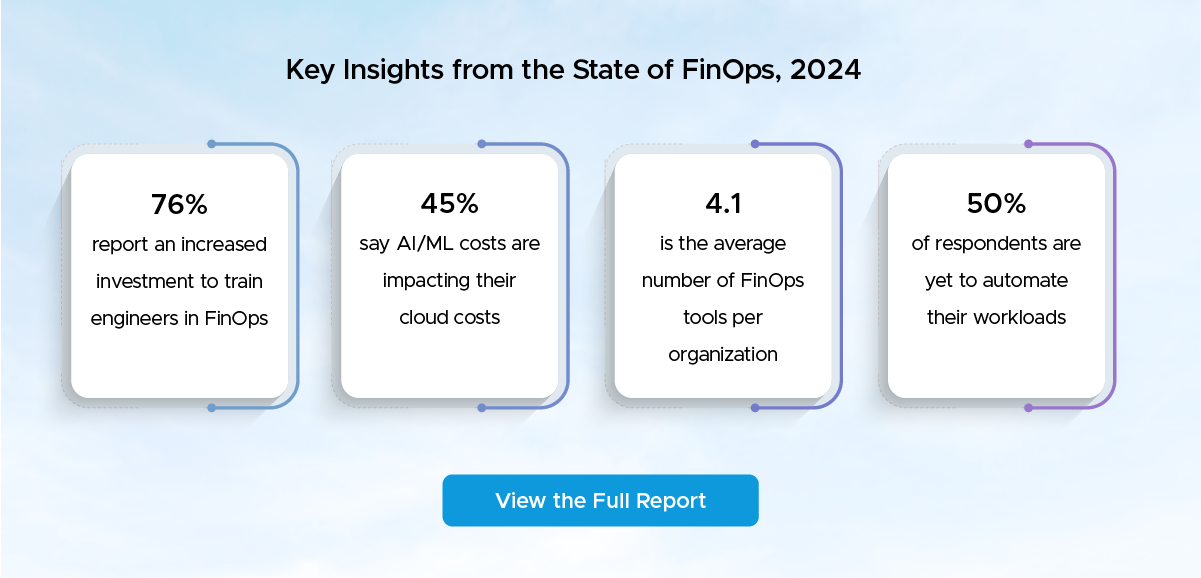
The Principles of FinOps
Implementing cloud FinOps in your organization is a continuous process, embracing a set of principles that act as guiding stars, ensuring your path toward cost efficiency is both strategic and adaptable. However, these principles need to be refined continuously to align with evolving business objectives and market dynamics.
- Foster Team Collaboration: This principle champions shared responsibility across all stakeholders involved in FinOps decision-making and implementation. This fosters a culture where finance, engineering, and business teams work together towards common goals.
- Cultivate Ownership: This principle focuses on building accountability for cloud expenditures. With practices like real-time cost allocation, tagging, chargebacks, and showbacks, along with measuring cost per unit, organizations can improve cost management and accountability.
- Data-Driven Decisions: This value urges organizations to align cloud usage and cost information with business outcomes. This enables informed decisions on where to invest more for maximum value or where to scale back to optimize expenses.
- Timely Reporting: Accessibility to real-time data ensures that decision-makers can swiftly act, facilitates quick feedback loops, and enables responsive and agile financial management.
- Centralized Leadership: A dedicated FinOps Team should spearhead the planning, implementation, and optimization of cloud cost optimization practices in the organization. This central leadership ensures consistent monitoring, value delivery, and cloud governance that aligns with the organization’s goals.
- Tapping into the Variable Cost Model: This principle re-emphasizes the importance of continuously adapting cloud consumption practices as per the dynamic nature of the cloud. This helps businesses make the most of the cloud’s flexible cost model, adjusting to business expansion and changing needs.
By implementing these cloud FinOps principles, a cloud consumer can unlock a pathway to not only manage cloud expenses more efficiently but also to drive strategic business value from cloud investments. Cloud FinOps is more than just a framework and could be considered a cultural transformation that steers organizations toward a future where cloud financial management is closely integrated to business objectives.
The FinOps Lifecycle
The six pillars of FinOps provide a foundation for cloud cost management, but successful practices require a dynamic approach. This is where an iterative framework like the FinOps Lifecycle comes into play. It involves three phases.
1. Inform - Establishing Cost Visibility
This phase is all about demystifying cloud expenses. The key action items include:
- Deploying tools to capture in-depth cost data.
- Analyzing major cost contributors to understand where the budget is being spent.
- Establishing benchmarks for monitoring cloud expenses over time.
- Creating cost allocation models that align expenses with specific business functions.
This phase sets the premise and enables everyone to base their decisions on solid data.
2. Optimize - Transforming Insights to Savings
This phase is where a team equipped with data and insights acts upon them. This includes acts where they:
- Adjust cloud resources to match actual needs, avoiding provisioning mismatches.
- Explore cost-saving options like RIs or Spot Instances for appropriate requirements.
- Automate resource provisioning and scaling, thereby preventing unnecessary spending.
- Negotiate with the cloud providers for savings or discounts based on existing usage and commitments.
3. Operate - Building a Cost-conscious Culture
This phase ensures cloud FinOps becomes ingrained in your organization’s DNA, with an increased focus on:
- Emphasizing accountability for cloud spend across the organization.
- Governance policies for responsible use of cloud resources to avoid wastage.
- Keeping a vigilant eye on cloud expenses, always on the lookout for better efficiencies.
- Revisiting and tweaking your approach to stay aligned with the business dynamics.
Due to its iterative nature, the cloud FinOps lifecycle becomes a closed loop, that invites continuous refinement and adaptation. This flexibility ensures that as your cloud infrastructure evolves, your approach towards managing costs also becomes optimized.
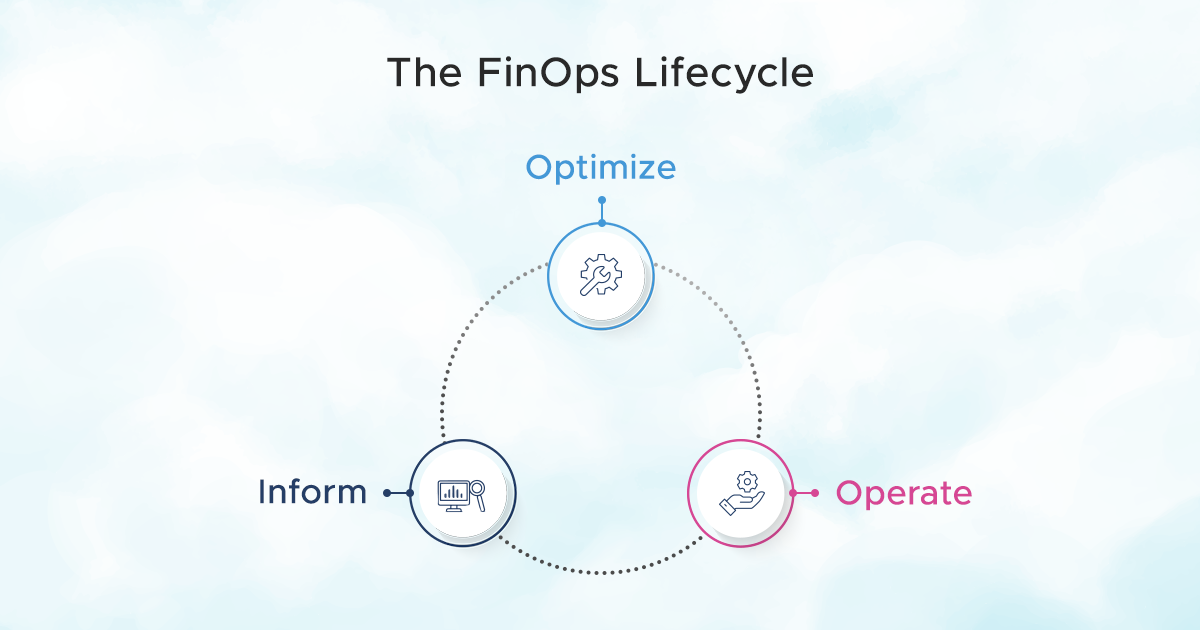
The FinOps Maturity Model
Another innovative framework introduced by the FinOps Foundation, the maturity model employs a phased approach to cloud FinOps implementation - Crawl, Walk, and Run. This model encourages businesses to gradually evolve their Finops capabilities in a way that aligns with their unique needs and scales with their growth.
- Crawl: At the beginning of their FinOps journey, organizations are in their Crawl phase, where the focus is on laying the groundwork. Minimal reporting tools and basic KPIs are established for insights that help mature the FinOps practice. The primary goal of this stage is to set the stage for more sophisticated optimization strategies, along with understanding and managing cloud costs.
- Walk: Businesses in the Walk phase have internalized FinOps practices across their teams. These practices are enhanced by technologies like analytics, automation, and refined processes, that cover more of the FinOps requirements. A few edge cases might be identified during cost monitoring, however, the focus remains on addressing the challenges that have the most significant impact on cloud financial health. In this phase, KPIs become more nuanced, reflecting a deeper engagement with cloud cost management and optimization strategies.
- Run: This phase signifies a mature FinOps practice, where organizations have successfully integrated FinOps principles across all their teams, with a strong emphasis on technology. The focus is on achieving very high goals and KPIs, with strategies in place to address even the most challenging edge cases. In this phase, companies have a thorough understanding of the cost variables - direct and indirect - as well as various cloud services, leveraging it to drive significant business value.
The guiding principle for organizations following the FinOps Maturity Model is to focus on maturing the areas that promise the highest business value. There should not be any haste to evolve through the phases, instead, ensure that the efforts to mature a FinOps capability are aligned with the overall success metrics. In simple terms, the priority should be to mature those capabilities that directly contribute to the financial and operational goals.
By adopting this model, companies become equipped to make informed decisions that optimize cloud spend, improve efficiency, and foster a culture of accountability among all stakeholders. The Crawl-Walk-Run phases are iterative, encouraging continuous improvement and adaptation to stay relevant in the dynamic landscape of cloud computing.
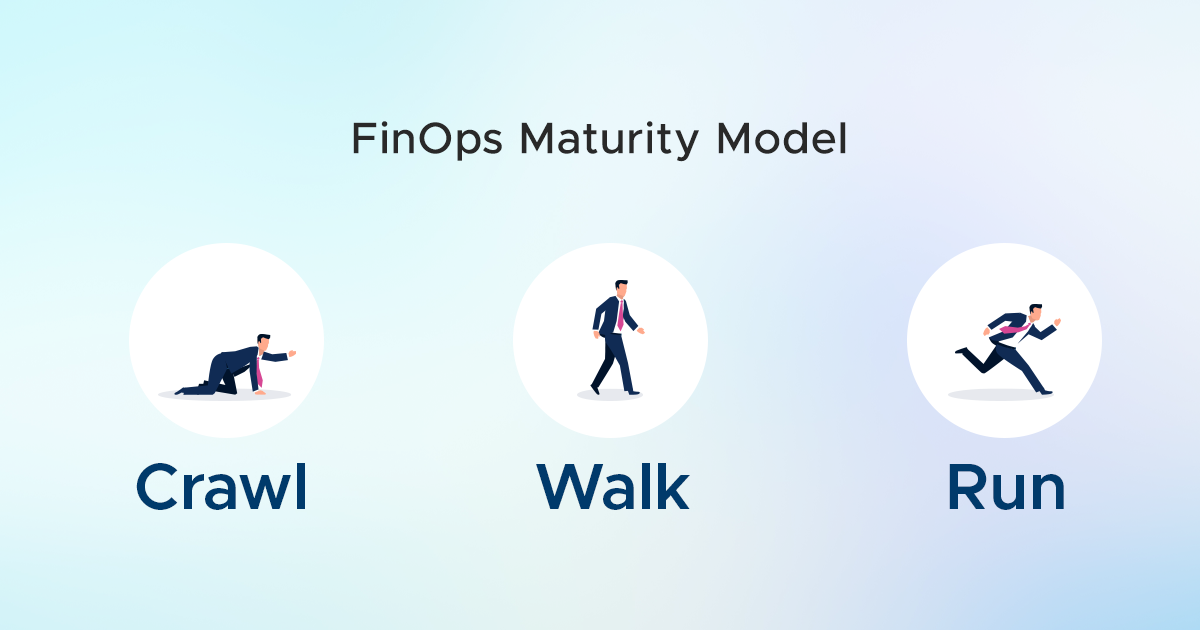
The FinOps Personas
In the cloud computing domain, optimizing the entire infrastructure of an organization and achieving proper ROI is akin to conducting an orchestra - everyone must play in sync, with a clear vision and mutual understanding. In essence, cloud FinOps should have diverse roles brought together to fine-tune the cloud’s potential. The key stakeholders behind this symphony include:
1. The Executive Suite
Titles: CTO, CIO, CFO, Head of Cloud, Head of Engineering
Role: Executives provide the direction for cloud FinOps initiatives. They ensure alignment with business goals, foster accountability, ensure transparency and help teams become more equipped for adhering to cloud budgets.
2. Leaders of Functional Units
Titles: Director of Cloud Optimization, Cloud Analyst, Business Operations Head
Role: Maximizing the business value of cloud investments by prioritizing cloud resource usage and optimization for daily operations and new launches. They aim to accelerate business growth while optimizing infrastructure costs.
3. Engineering and Business Operations
Titles: Software Engineer, DevOps Engineer, Cloud Architect, Delivery Manager
Role: Responsible for building and maintaining cloud infrastructure efficiently. They identify cloud cost-saving opportunities by resource optimization, cloud usage anomaly detection, and exploration of cost-effective delivery options.
4. Finance and Procurement
Titles: Finance Manager, Analysts, Procurement Specialists
Role: Gather insights from the cloud FinOps teams to negotiate favorable contracts with cloud providers. They could also work with the engineering teams to find a balance between performance requirements and cost benchmarks, by building guardrails.
5. The FinOps Team
Title: FinOps Practitioner, Cloud FinOps Expert
Role: Lead the cultural and operational shift required for successful cloud cost optimization practices. They draft cost management policies, educate the organization on cloud FinOps principles, help establish clear cloud cost visibility, set cost benchmarks, and also guide in budgeting and forecasting.
The magic of FinOps lies in collaboration, where each group plays its part with commitment and understanding. The result is a well-tuned performance that delivers:
- Shared Responsibility: A collective ownership of the cloud strategy, where everyone plays a part in harmonizing cost, provisioning, and performance.
- Informed Choices: Decisions are guided by actionable insights, ensuring that each move is a step towards greater efficiency.
- Strategic Alignment: Cloud resources and investments align in harmony with business objectives, amplifying impact where it matters the most.
By encouraging a symphony of efforts across these key roles, organizations can orchestrate a cloud strategy that is financially sustainable as well as technically advanced, creating a future where efficiency and innovation play a perfect duet.
The Challenges in Cloud FinOps
Even with the various cloud FinOps roles mapped out across the stakeholders, there are a host of challenges that persist in cloud FinOps implementation. These obstacles hinder organizations from fully realizing the benefits of cloud cost management and optimization.
If we were to list out the top 5 cloud FinOps challenges faced by businesses worldwide, they would include:
Cloud Waste: Unnecessary cloud resource usage and the corresponding costs, due to exceeded capacities, overprovisioned resources, and underutilized discounted instances remain significant challenges to Finops teams. Without mitigating this cloud waste, cloud cost optimization will always be incomplete and unsustainable.
Lack of Cost Visibility and Granularity: Without adequate cloud cost visibility, it is difficult to zero in on the cost drivers and optimize spending. Robust cloud cost monitoring and reporting, leveraging advanced tools, is necessary to track and analyze cost data at a granular level.
Complex Cost Allocation and Tagging: Properly tagging and allocating costs to different departments, projects, or teams remain a challenge due to the lack of transparent, fair cost allocation strategies. Establishing cost centers and utilizing automation for cost allocation and tagging might be the right way ahead, which again, needs specialized tools.
Lack of Collaboration: Even with multiple teams carrying out their FinOps responsibilities, these teams getting siloed with limited collaboration poses a significant challenge in cloud FinOps. Without cross-functional synergy, there would be a lack of shared understanding of cloud costs, budgetary constraints, complicated spending patterns, and a disconnect in resource provisioning decisions.
Multi-Cloud and Hybrid Cloud Complexities: Optimizing costs in a multi-cloud or hybrid cloud environment presents its own set of challenges. This includes the need for maintaining peak cloud cost visibility, interoperability issues, complex billing structures, difficulty in managing multiple interfaces, data transfer costs, and network latency issues. Such environments could also create vendor lock-in constraints and there might be a lack of proper talent who can manage such an infrastructure.
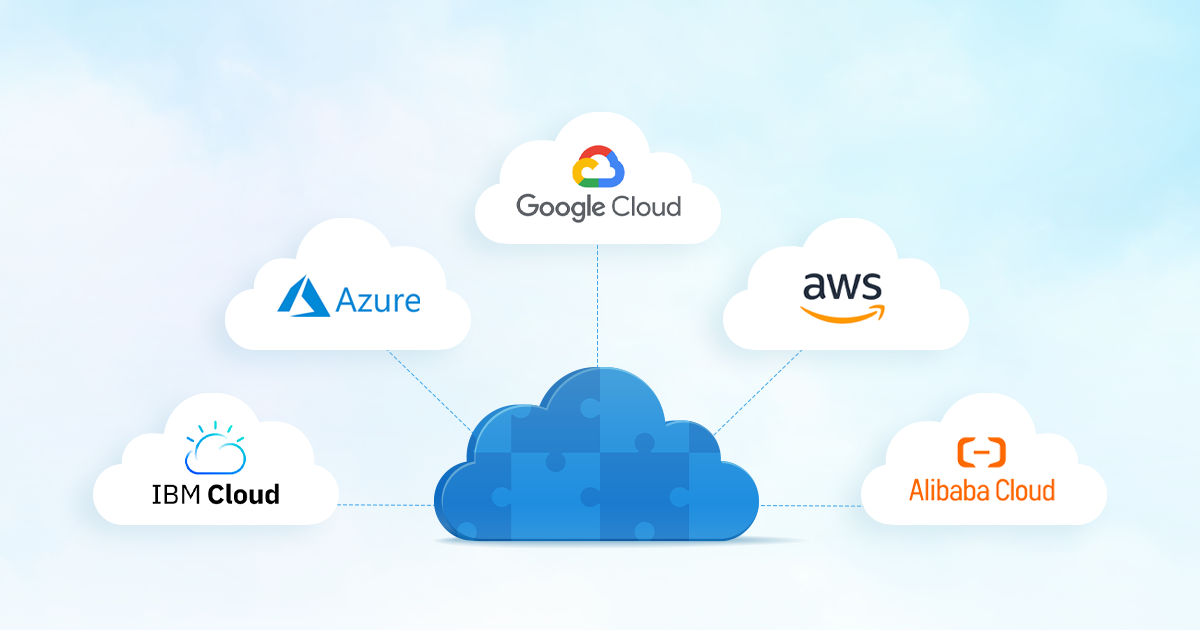
These challenges, along with other issues which include a lack of proper FinOps talent, governance, and compliance issues, and resource utilization problems, could create roadblocks to effective cloud FinOps implementation and successful cloud cost optimization. Tackling these hurdles needs concerted efforts from the organization by implementing certain best practices.
Cloud FinOps Best Practices
The challenges to FinOps implementation could be mitigated by integrating certain best practices into the cloud FinOps strategy. While some of these practices require the use of certain tools or skills, some might require an entire cultural change. These cloud cost optimization best practices include the following.
- Automated Resource Management: To handle unnecessary cloud resource usage and the resulting cloud waste, organizations can implement resource monitoring and management tools. Resource management tools of today are laced with automation and AI capabilities, which conduct regular rightsizing assessments and make it easier to match workload demands with resources. These features help businesses to eliminate cloud waste and improve cost efficiency.
- Integrating Cost Visibility Tools: There are advanced cost management tools in the market that help gain comprehensive visibility into cloud costs, at a granular level. These tools also offer robust reporting and analytics capabilities, which help track spending trends, identify cost drivers, and facilitate enhanced cloud cost monitoring processes.
- Establishing Cost Centers: Cloud cost centers are an effective way to streamline cost allocation and tagging. By defining standardized cost allocation frameworks, organizations can ensure transparency and fairness in cost distribution across different business units. Leveraging automation tools can further simplify the cost allocation process, by tagging resources based on predefined rules which ensure consistency and accuracy in cost attribution.
- Promoting Cross-Functional Collaboration: Organizations should establish regular communication channels and forums for cloud FinOps stakeholders to share insights, challenges, and best practices. Conducting training sessions and workshops can educate them on the importance of collaboration in cloud cost management. A rapport between Finance, IT, and Business teams can ensure alignment of cloud initiatives with strategic objectives and drive collective ownership of cloud cost optimization efforts.
- Unified Cost Management Solutions: Implementing a centralized cloud cost optimization platform is crucial in managing complexities associated with multi-cloud and hybrid cloud environments. These solutions provide a single pane of glass view across multiple cloud environments. Additionally, by upskilling employees for expertise in multi-cloud management, organizations can effectively navigate the cloud-vendor-specific challenges and optimize costs across diverse cloud platforms.
By embracing these best practices and strengthening the governance and compliance frameworks, organizations can address their cloud FinOps challenges, achieving greater efficiency and cloud cost savings.
Working with a Cloud FinOps Partner
While these cloud FinOps frameworks and best practices empower organizations to step ahead and optimize cloud costs, building and maintaining a FinOps practice successfully could be a challenging feat.
As tempting as the result of huge cloud cost savings, the journey toward cloud cost optimization is not always smooth sailing. That is where a cloud FinOps expert could be onboarded and there are multiple reasons why it is a smart move.
Snagging the Right Crew is Tough
Finding and assembling a FinOps team involves excessive scouting for cloud FinOps pros who are technically advanced and also align with the organizational philosophy. Even if you are ready to make that effort, so is everyone else in the market, which makes finding cloud FinOps talent nothing less than hunting treasure.
Turbulent Internal Waves
Resistance to change is a very common challenge in almost all organizations and this makes getting FinOps to mesh with your team’s rhythm even more difficult. However, a cloud FinOps expert would be adept at bridging the gaps between finance, engineering, and business functions, ensuring your journey to cost optimization doesn’t hit the rough seas.
Access to the Finest Tools and Skills
FinOps partners are fully equipped with the latest cloud cost optimization capabilities, tools, and skillsets. This could include in-depth analytics, automation, AI/ML, and comprehensive dashboarding and reporting features. Accessing these individually could be much more expensive.
Unlocking Secret Hacks and Hidden Discounts
A cloud FinOps partner is not just an advisor or facilitator, they also know the secret paths to discounts and special deals with cloud vendors, which might not be accessible for someone who is sailing solo.
Sailing with the Current
The FinOps domain is like a vast, ever-changing sea and only a dedicated cloud FinOps expert can keep a keen eye on the horizon, and understand new updates, policy changes, vendor transformations, and technology enhancements. With the cloud FinOps partner, businesses could easily navigate through the evolving landscape and stay ahead of the game.
More Savings for Lesser Investments
Building a FinOps discipline from scratch involves a lot of effort, time, resources, and especially, financial backing. Partnering with a cloud FinOps expert on the other hand is often very much economical, and it also helps you skip multiple steps and dive straight into reaping the rewards of cloud cost optimization.
Cloud FinOps Tools - Must-have Features
Let’s take a look at the breakdown of the key factors to weigh in when selecting the ideal cloud FinOps solutions for any business.
- In-depth Cost Insights: It is crucial to have a clear view of cloud spending across various areas like services, departments, and projects. This detailed visibility helps make well-informed decisions.
- AI and Automation Capabilities: It is always an advantage to have tools that use the power of AI/ML and Automation to optimize resources, mitigate cloud waste, and optimize cloud costs efficiently. These enhancements could dramatically improve cost-saving efforts.
- Multi-Cloud and Hybrid Cloud Support: The cloud FinOps partner should be able to seamlessly manage multiple cloud providers and hybrid environments. While the business would be agnostic to any vendor lock-ins, the cloud FinOps solution could make sure all the resources across multiple infrastructures are cost-optimized and streamlined.
- Proactive Budgeting and Reporting: Cloud FinOps solutions should empower you to proactively manage your budget with real-time spending alerts and customizable reporting dashboards. This helps immensely when collaborating with multiple teams within the organization.
Comprehensive Cloud FinOps Partner
Rather than choosing multiple cloud FinOps solutions for specific capabilities and features, a certain handful of cloud FinOps solutions offer a comprehensive approach to cloud cost optimization. They include all of the features listed above, along with capabilities like Automated RI Management, Smart Recommendations, FinOps Consulting, Architectural Reviews, and more.
Working with an all-in-one cloud FinOps provider helps organizations gain access to a wide range of services that maximize cloud investments, expert guidance on architectural decisions, and support in delivering enhanced business value.
Pro Tip: It’s important to keep up with the latest FinOps industry trends, and understand what your competition is doing right. How about understanding the market demands better based on insights from 450+ businesses worldwide? Download our latest Whitepaper for a comprehensive and interesting analysis of the FinOps Vendor Market.

How CloudKeeper Becomes the Best Choice?
Now that we've seen the benefits of having a comprehensive cloud FinOps partner, the big question arises: How do you pick the perfect one from the crowded marketplace to embark on your cloud cost optimization journey?
That's where CloudKeeper steps in – your go-to partner for cloud FinOps excellence. Here's why CloudKeeper is your perfect companion on the journey to optimizing cloud expenses:
Expertise and Partnerships:
CloudKeeper isn't just any cloud FinOps provider – we bring almost a decade and a half of expertise and prestigious partnerships, including AWS Premier Partnership, Microsoft Azure Solutions Partnership, and Premier Partnership with the FinOps Foundation. This extensive experience and industry recognition ensure top-notch solutions and expert guidance for your cloud environment.
Tailored Solutions for Every Need:
We recognize that each organization's cloud requirements are unique. CloudKeeper offers a diverse range of solutions to meet these varied needs for both AWS and Azure infrastructures:
- CloudKeeper AZ: This solution guarantees savings through comprehensive rate, usage, and process optimization. With no upfront commitment required, CloudKeeper AZ provides complete flexibility for your organization. It manages all aspects of cloud FinOps, delivering contractually guaranteed savings instantly.
- CloudKeeper Auto: Say goodbye to the hassle of managing Reserved Instances (RIs). CloudKeeper Auto automates RI buying and selling based on your infrastructure needs, offering On-Demand instances at RI pricing.
- CloudKeeper EDP+: Looking for a cost-effective approach to the AWS Enterprise Discount Program? CloudKeeper EDP+ offers significant discounts compared to standard rates, even with lower annual spending. The solution also offers AWS Partner-led Enterprise Support at a lower cost while allowing you to retain 100% of your achieved savings.
- Unveiling Hidden Costs with CloudKeeper Lens: CloudKeeper Lens is your gateway to unlocking invaluable insights into cloud costs. This powerful tool offers a granular view of your cloud spending patterns, identifying resource-level costs and variations through a heatmap. Initially offered for AWS cloud, CloudKeeper Lens has now extended its availability to Azure infrastructure as well.
Beyond Cost Savings: Expert Cloud FinOps Guidance
CloudKeeper doesn't stop at providing cost optimization tools. We offer comprehensive cloud FinOps Consulting Services and Well-Architected Reviews to guide you every step of the way. From developing tailored cost-optimization strategies to implementing effective tagging practices, our experts are here to ensure your cloud journey is smooth and efficient.
Zero-Hassle, Zero-Risk Approach
At CloudKeeper, we believe in making cloud cost optimization effortless for you. Most of our solutions require zero upfront costs, zero effort from your IT team, and zero commitment from your organization. Our RI Management platform, CloudKeeper Auto, operates on a results-based pricing model, where our fees are a small percentage of the savings you achieve.
With CloudKeeper by your side, rest assured to be navigating the cloud cost optimization landscape seamlessly, empowering your organization to unlock the full potential of cloud efficiency and savings.
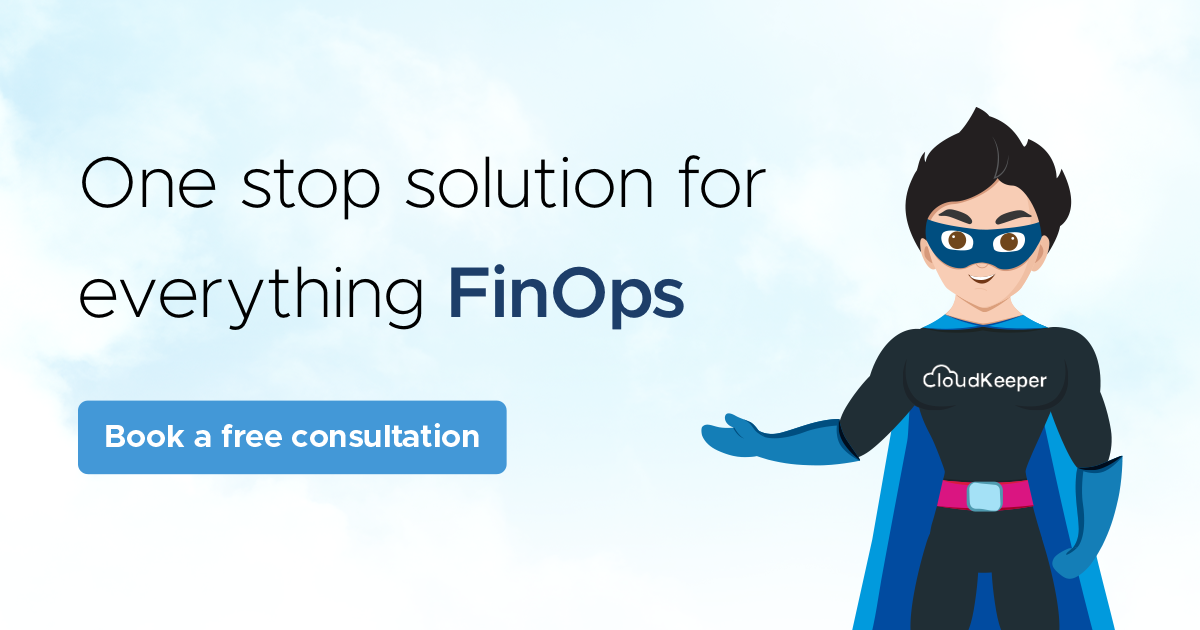
The Future of Cloud FinOps
FinOps and Cloud Cost Optimization is a rapidly evolving domain that is becoming a strategic discipline that fosters collaboration along with delivering immense business value. The future of cloud FinOps looks exciting and here are some trends shaping its path ahead:
AI-powered Optimization: Artificial intelligence will play a prominent role in cloud cost analytics and prediction.
AI algorithms specially designed for cloud FinOps can process vast amounts of data to identify spending patterns, forecast cost requirements, and recommend cost optimization avenues with features like -
- Proactive identification of potential budget overruns.
- Pinpointing unauthorized usage, security breaches, and resource waste.
- Real-time cost insights by answering queries and offering recommendations.
Also, the availability of Generative AI-based capabilities could be used to create realistic “what-if” scenarios in cloud cost optimization. This would enable FinOps teams to understand the potential cost impact of strategies like scaling resources, adopting a new cloud service, or migrating workloads to different cloud providers, and make informed decisions.
Decentralized Cloud Cost Management: A shift is underway towards empowering individual teams to manage their cloud costs. This fosters a culture of accountability and ownership, leading to more efficient resource utilization.
Unified Cost Visibility and Management: With the increase in the adoption of multi-cloud and hybrid cloud infrastructures, managing cloud costs become a challenge. Future FinOps solutions will offer unified cloud cost visibility and management, that can handle these complexities.
Adopting DevSecFinOps: The concept of DevSecFinOps shows the importance of including FinOps from the very beginning of the development process, alongside security considerations. This signifies a more holistic approach to cloud resources management. Regular audits, reviews, and security mechanisms will be a part of cloud FinOps strategies.
Sustainability in the Cloud: Cloud FinOps will play an important role in optimizing cloud resources for energy efficiency, and reducing the environmental footprints. FinOps solutions and tools will be built to measure and optimize cost from a sustainability perspective. Organizations are also increasingly adopting green computing principles in their cloud FinOps practices.
The possibilities of how the future of FinOps would look are not limited to the above list. Finops and cloud computing are dynamic and ever-evolving fields of technology. By embracing the latest trends in the domain, organizations can leverage cloud FinOps as a strategic tool to achieve sustainable IT transformation and ensure responsible cloud adoption.
Conclusion
The importance of a cloud cost optimization strategy is more critical than ever in today’s digital landscape. By embracing and learning the foundational concepts of cloud FinOps, businesses can easily optimize their cloud infrastructure to drive strategic value.
The shared responsibility model of cloud FinOps principles emphasizes the theme of collaborations and the importance of team synergy in achieving FinOps success. Adding to this mix is the necessity of working hand in hand with trusted cloud FinOps partners, who can unlock new opportunities for cost optimization and innovation, helping organizations propel ahead in the market.
With proper cloud FinOps best practices in place, no businesses would ever need to worry about their new launches and innovations eating up their budgets. Cloud cost optimization is an efficient and sustainable way to build a future where executives strategize ambitiously, engineers build without being scared of costs and marketers celebrate their campaigns with no one frowning upon them.
Did you know CloudKeeper offers an end-to-end Well-Architected Review of your cloud infrastructure, completely free of cost? Talk to us now.
